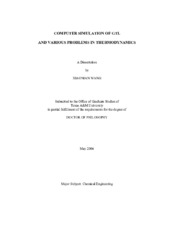| dc.contributor.advisor | Eubank, Philip T. | |
| dc.creator | Wang, Xiaonian | |
| dc.date.accessioned | 2005-08-29T14:35:46Z | |
| dc.date.available | 2005-08-29T14:35:46Z | |
| dc.date.created | 2003-05 | |
| dc.date.issued | 2005-08-29 | |
| dc.identifier.uri | https://hdl.handle.net/1969.1/2210 | |
| dc.description.abstract | This dissertation intends to provide new tuning techniques for several simple cubic equations of state (EOS) to improve their accuracy in calculating fluid phase equilibrium. It also provides graphical tools to predict some phase equilibrium phenomena from activity coefficient models. Finally, it presents simulation results for a new gas-to-liquids process.
Saturation Properties for Fluids: By deriving a new identity linking the heat of vaporization for pure components to the EOS, we are able to find new expressions for the two constants a & b in the EOS. These new expressions then allow tuning of both constants a and b to experimental saturation properties at subcritical temperatures. These new tuning procedures prove effective to the point where the simpler Redlich-Kwong EOS provides better results with our procedure than does the usually superior Peng-Robinson EOS with conventional procedures.
Activity Coefficient Models: This dissertation shows the flexibility of four activity coefficient models in the prediction of three fluid phase equilibrium phenomena. From these models we successfully developed new graphs that allow one to identify the presence of any of the three phenomena by visual inspection without performing a complex calculation as seen in current texts.
Remote Natural Gas: This dissertation presents simulation results of a new gas-to-liquids process which converts natural gas to liquid transportation fuels.
Based on the assumption of adiabatic reactions, our simulation results show that methane conversion increases with higher reaction temperature and longer residence times. Hydrogen can both inhibit methane decomposition and reduce coke formation. The rich components in the natural gas are found to decompose very fast and they have a vast quenching effect on the whole reactions. Recycling of unreacted methane also increases overall methane conversion. Finally, our simulator provides very close prediction of the experimental results from a pilot plant. Thus, we conclude that the simulation work is basically successful in fulfilling the goal of this research. | en |
| dc.format.extent | 1638838 bytes | en |
| dc.format.medium | electronic | en |
| dc.format.mimetype | application/pdf | |
| dc.language.iso | en_US | |
| dc.publisher | Texas A&M University | |
| dc.subject | Simulation | en |
| dc.subject | GTL | en |
| dc.subject | Thermodynamics | en |
| dc.title | Computer simulation of GTL and various problems in thermodynamics | en |
| dc.type | Book | en |
| dc.type | Thesis | en |
| thesis.degree.department | Chemical Engineering | en |
| thesis.degree.discipline | Chemical Engineering | en |
| thesis.degree.grantor | Texas A&M University | en |
| thesis.degree.name | Doctor of Philosophy | en |
| thesis.degree.level | Doctoral | en |
| dc.contributor.committeeMember | Ford, David M. | |
| dc.contributor.committeeMember | Hall, Kenneth R. | |
| dc.contributor.committeeMember | Barrufet, Maria A. | |
| dc.type.genre | Electronic Dissertation | en |
| dc.type.material | text | en |
| dc.format.digitalOrigin | born digital | en |


